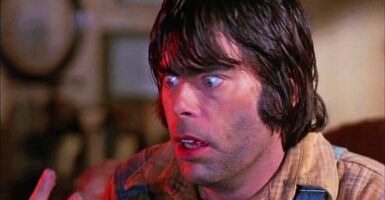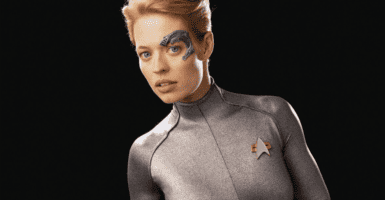Other Places Videos Celebrate Iconic Game Settings From Portal 2, Dead Space, And More
This article is more than 2 years old
In any science fiction movie or series, the setting almost always becomes a character in and of itself. Whether unfolding on a distant alien world, a claustrophobic starship, or an alternative version of our own place and time, science fiction needs to provide a world that feels unique and real, so that whatever story is unfolding feels believable and engaging.
For video games, this is all the more true. With games, you’re not just watching a story unfold on the screen, you’re immersed in it, experiencing it, and the best games make you feel that you truly have been transported into a different world. The catch-22 of that reality, however, is that we often miss out on the details of those elaborate game worlds because we’re too busy running, gunning, or driving through it, full speed ahead. YouTuber ultrabrilliant’s “Other Places” series of videos aims to rectify that, providing beautiful tours of some of the most unforgettable game worlds out there, accompanied by thematically appropriate music from each game’s composers.
Up top, we have BioShock Infinite’s floating city of Columbia, circa 1912. The game casts players as Booker DeWitt, a former Pinkerton agent who travels to the floating city in order to track down Elizabeth, a young woman who has been held captive in the city most of her life. Upon arriving, Booker discovers a city of marvels, mysteries, and violence, with Elizabeth caught between the factions of the elitist Founders and the people-first Vox Populi. Columbia is constructed of a number of floating islands and buildings, all linked by skyrails that Booker can book along when he needs to get from point A to point B quick-like. The accompanying music is by composer Garry Schyman.
Next, we’ve got Pandora, the alien world at the heart of the Borderlands games. Originally intended as a more straightforward futuristic first-person shooter, the Borderlands games eventually evolved into something unique, a cartoonish, over-the-top adventure in an insane and frequently hilarious world where players can seek their fortune while shooting an array of preposterous enemies with a ridiculously large array of weaponry. The first game was pretty singular when it came to its locations, serving up a frontier world that was mostly deserts populated by ramshackle settlements. Borderlands 2 still has plenty of that, but provides a bit more geographical variety as well. The musical track is “Sanctuary” by Jesper Kyd.
And then there’s the interior of the USG Ishimura, the seemingly dead mining vessel engineer Isaac Clarke is sent to investigate and repair in the first Dead Space game. This is one of the best videos on this list, because, along with the unsettling music from composer Jason Graves, it perfectly sets the mood for Isaac’s terrifying, claustrophobic explorations of the Ishimura, never sure when some horrible creature is going to pop up behind him or drop out of a vent onto his head. Music is a key element of crafting many frightening experiences, but you can also see the masterful design work designed to keep the player from ever feeling safe, ranging from flickering lights to strobing alarms to deep, impenetrable shadows. There’s a reason why Dead Space still stands as one of the scariest games ever made. The music is the Dead Space theme by composer Jason Graves.
Valve’s Half-Life 2 couldn’t be a more different experience than Dead Space. The video explores the game’s setting of “City 17,” one of numerous settlements in a world caught under the totalitarian bootheel of the alien empire known as the Combine. The city itself is fairly picturesque, but the Combine’s presence is everywhere, from checkpoints manned by heavily armed troops to the looming, insectile tripods called Striders. The mix of a European architecture and the towering, angular spire of the Citadel, the Combine’s headquarters on Earth. Sadly, City 17 didn’t fare too well during the Episode Two expansion… The music is “Infraradiant” by Kelly Bailey.
Next up is the ship at the core BioWare’s Mass Effect series, the Normandy. More specifically, the Normandy SR-2. The original vessel is destroyed in the opening moments of Mass Effect 2, and a redesigned, significantly larger version is introduced later in the game. Aside from removing the original ship’s inexplicably slow elevator, the SR-2 adds all manner of groovy improvements, including a research lab, an armory, and a computer core housing the ship’s artificial intelligence, EDI (voiced by Battlestar Galactica’s Tricia Helfer, no less). As with many a fictional starship before it, the Normandy really does become a character in and of itself, the one constant in Commander Shepard’s adventures across the galaxy. The music is “New Worlds” by Jack Wall.
Mirror’s Edge is a mix of the stunning and the frustrating, challenging players with first-person parkour gameplay that can be breathtaking 10% of the time and an exercise in controller-flinging madness the rest. But even at its most annoying, Mirror’s Edge is consistently gorgeous. The pristine architecture of the game’s unnamed city mixes stark white buildings with splashes of vibrant color. The ever-present color red actually serves as a gameplay element, subtly providing a path for the player to follow if they’re having trouble figuring out where they’re supposed to go next. Dystopia has never looked so damn pretty, and when you factor in the game’s gorgeous soundtrack, Mirror’s Edge might not be that good a game, but it does make for a beautiful screensaver. The track is “Pirandello Kruger” by Solar Fields.
Valve’s 2007 game Portal was a surprise mega-hit, and the sequel served up more of all the things players loved the first time around. Once again, the always silent protagonist Chell finds herself exploring the massive testing facilities of Aperture Science, this time partnered with a “personality core” named Wheatley (voiced by Stephen Merchant). Once again, the player must figure out ways to navigate through challenging — and frequently hilarious — puzzles using the Portal gun. In addition the thrilling, brain-teasing gameplay, Portal 2 also uses the setting to reveal backstory about Aperture Science and its founder, Cave Johnson (voiced with aplomb by J.K. Simmons). By the time all is said and done, Portal 2 even takes players to the Moon… The music is “I Made It All Up” by Mike Morasky.












